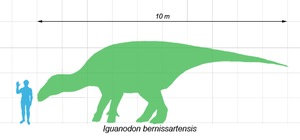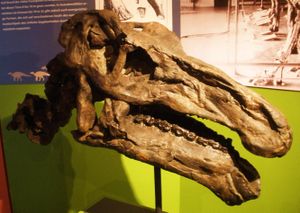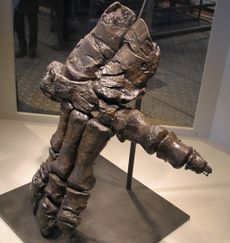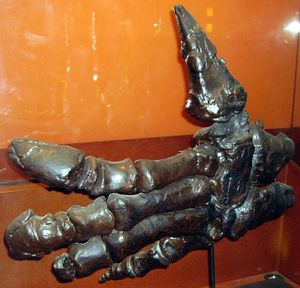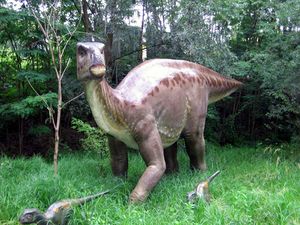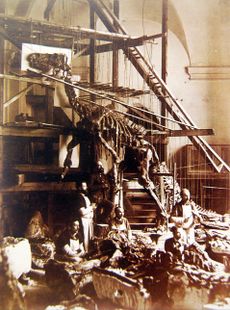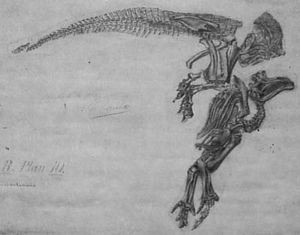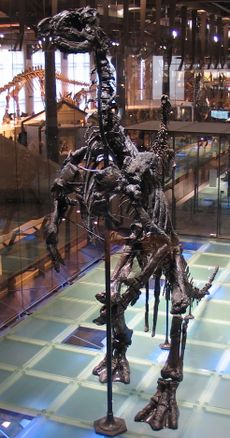إگوانودون
خطأ لوا في وحدة:Automated_taxobox على السطر 116: attempt to call field 'hasConnectingTerm' (a nil value).
Iguanodon ( /ɪˈɡwɑːnədɒn/ i-GWAH-nə-don; meaning "iguana-tooth") is a genus of ornithopod dinosaur that existed roughly halfway between the first of the swift bipedal hypsilophodontids of the mid-Jurassic and the duck-billed dinosaurs of the late Cretaceous. While many species have been classified in the genus Iguanodon, dating from the late Jurassic Period to the late Cretaceous Period of Asia, Europe, and North America, research in the first decade of the 21st century suggests that there is only one well-substantiated species: I. bernissartensis, which lived from the late Barremian to the earliest Aptian ages[2] (Early Cretaceous) in Belgium and possibly elsewhere in Europe, between about 126 and 125 million years ago. Iguanodon were large, bulky herbivores. Distinctive features include large thumb spikes, which were possibly used for defense against predators, combined with long prehensile fifth fingers able to forage for food.
كان الإگوانودون هو ثاني ديناصور يُسمى رسمياً بعد الميغالوصور، وكان قد اكتشف عام 1922 ثم وصفه الجيولوجي الإنكليزي جديون مانتل بعد ذلك بثلاث سنوات. وقد كان هو والميغالوصور والهيلايوصور يُمثلون الأجناس الثلاث الأولى التي استخدمت في الأصل لتعريف الديناصورات. يُصنف ديناصور الإگوانودون الضخم العاشب ضمن مَجموعة الإگوانودونيا (وهي عبارة عن فرع وليست صنفاً مُعتمداً علمياً) مع الهادروصوريات بطية المنقار، أما تصنيفه العلمي فإنه لا يَزال مجالاً للدراسة حول ما إذا كان يَجب أن يُقسم إلى عدة أجناس أم يَبقى كما هو.
تطور الفهم العلميّ للإگوانودون عبر الزمن معَ الحصول على معلومات جديدة من الأحافير المُكتشفة. أتاحت العينات الكَبيرة من هذه المَجموعة - مثل الهياكل العظمية شبه المُكتملة المُستخرجة من طبقتي عظام مَعروفتين - للباحثين أن يَضعوا فرضيات توضح جزءاً كبيراً من مَظهر الإگوانودون الحي ونمط حياته، بما في ذلك حركته وتغذيه وسلوكه الاجتماعي. وبما أن الإگوانودون هو من أوائل الديناصورات المَعروفة جيداً للعلم فقد شغل حيزاً صغيراً لكن ملحوظاً في الاهتمام الشعبي بالديناصورات، وقد ازداد تمثيله في الإنتاجات الفنية بشكل مَلحوظ مع ازدياد المعلومات والتفسيرات العلمية حول طبيعته وحياته.
. . . . . . . . . . . . . . . . . . . . . . . . . . . . . . . . . . . . . . . . . . . . . . . . . . . . . . . . . . . . . . . . . . . . . . . . . . . . . . . . . . . . . . . . . . . . . . . . . . . . . . . . . . . . . . . . . . . . . . . . . . . . . . . . . . . . . . . . . . . . . . . . . . . . . . . . . . . . . . . . . . . . . . . .
الوصف
كانت الإگوانودونات ديناصورات عاشبة كبيرة بطيئة الحركة يُمكنها السير على ساقين أو أربع في حال تطلب الأمر.[3] أكثر نوع مَعروف من الإگوانودون هو "إگوانودون. برنيسارتنسس" (أو اختصاراً "إ. برنيسارتنسس")، ويُقدر أن وزنه بلغ بالمتوسط حوالي 3 أطنان[4] وطوله عند البلوغ 10 أمتار، وذلك مع أنه من المُحتمل أن طول بعض العينات التي اكتشفت من هذا النوع بلغ 13 متراً.[5] كانت تملك الإگوانودونات جمجمة ضخمة وطويلة بالرغم من أنها نحيلة، وقد كان لها منقار خال من الأسنان وربما مُغطى بالكيراتين، أما أسنانها فهي شبيهة بأسنان الإگوانا التي استمد منها الجنس اسمه بالرغم من أنها أضخم بكثير وأقرب إلى بعضها البعض.[3]
كانت ذراعا الإگوانودون طويلتين وقويتين، فربما عادل طولهما 75% من طول الساق عند إ. برنيسارتنسس،[5] لكن بالمقابل فقد كان كفاها صُلبين وغير مرنين وربما امتلكا وزناً كبيراً جداً خصوصاً الأصابع الثلاث الوُسطى.[3] أما الإبهام فقد برز منه مخلب كبير مخروطي الشكل، بينما نتأ هو نفسه من مَكان جانبي في الكف بعيداً عن الأصابع الثلاث الوُسطى. في مُحاولات إعادة البناء الأولى للإگوانودون كان يُوضع مخلبه الكبير على أنفه، لكن الأحافير التي اكتشفت لاحقاً أظهرت الطبيعة الحقيقية لمخلب الإبهام هذا،[6] وذلك مع أن استخدامه الفعلي لا زال مَوضع جدل. فمن المُمكن أن الإگوانودون استخدم مخلب إبهامه الكبير للدفاع عن نفسه، أو ربما للالتقاط الطعام أيضاً، فكلاهما مُحتمل. كان خنصر الإگوانودون مُمتداً وقصيراً، وربما استخدمه لتحريك الأشياء أو التلاعب بها نظراً لموقعه. كانت سيقان هذه الديناصورات قوية، لكنها ليست مُهيأة للركض بالرغم من ذلك، وقد كانت تملك كل قدم من قدميها ثلاثة أصابع. أما عمودها الفقري وذيلها فقد دعمهما وصلبهما وتر الساق المُتعظم، فقد كانت أوتارها تتحول إلى عظام خلال حياتها، وعادة ما لا تضمن هذه العظام في هياكل الديناصورات العَظمية المَعروضة في المتاحف.[3]
التبويب والأصول
 مقالة مفصلة: إگوانية الأسنان
مقالة مفصلة: إگوانية الأسنان
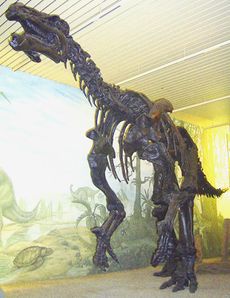
The cladogram below follows an analysis by Andrew McDonald, 2012.[7]
| Iguanodontia |
| ||||||||||||||||||||||||||||||||||||||||||||||||||||||||||||||||||||||||
علم الأحياء العتيقة
التغذي
Posture and movement
Thumb spike
Possible social behaviour
علم الأمراض العتيقة
Evidence of a fractured hip bone was found in a specimen of Iguanodon, which had an injury to its ischium. Two other individuals were observed with signs of osteoarthritis as evidenced by bone overgrowths in their anklebones which are called osteophytes.[8]
الاكتشاف والتاريخ
. . . . . . . . . . . . . . . . . . . . . . . . . . . . . . . . . . . . . . . . . . . . . . . . . . . . . . . . . . . . . . . . . . . . . . . . . . . . . . . . . . . . . . . . . . . . . . . . . . . . . . . . . . . . . . . . . . . . . . . . . . . . . . . . . . . . . . . . . . . . . . . . . . . . . . . . . . . . . . . . . . . . . . . .
Gideon Mantell, Sir Richard Owen, and the discovery of dinosaurs
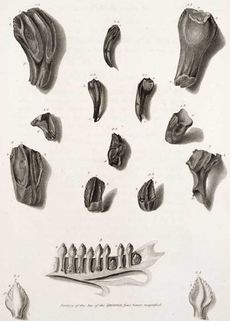

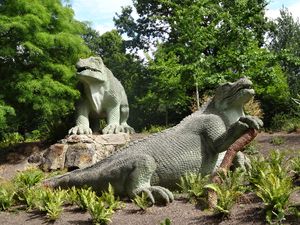
Bernissart
الأبحاث الحالية
الأنواع
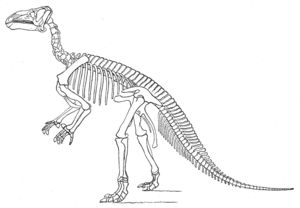
وصلات خارجية
- The Bernissart Iguanodons (Iguanodon herd found in Belgium).
- Mantell's Iguanodon tooth in the collection of the Museum of New Zealand Te Papa Tongarewa
- ^ Francisco J. Verdú; Rafael Royo-Torres; Alberto Cobos; Luis Alcalá (2015). "Perinates of a new species of Iguanodon (Ornithischia: Ornithopoda) from the lower Barremian of Galve (Teruel, Spain)". Cretaceous Research. 56: 250–264. doi:10.1016/j.cretres.2015.05.010.
- ^ Carpenter, K.; Ishida, Y. (2010). "Early and "Middle" Cretaceous Iguanodonts in Time and Space". Journal of Iberian Geology. 36 (2): 145–164. doi:10.5209/rev_JIGE.2010.v36.n2.3.
- ^ أ ب ت ث The Dinosauria. University of California Press. pp. 413–437.
{{cite book}}: Cite has empty unknown parameters:|lay-date=,|subscription=,|nopp=,|last-author-amp=,|name-list-format=,|lay-source=,|registration=, and|lay-summary=(help) - ^ Dinosaurs: The Encyclopedia. McFarland & Co. pp. 490–500.
{{cite book}}: Cite has empty unknown parameters:|lay-date=,|subscription=,|nopp=,|last-author-amp=,|name-list-format=,|lay-source=,|registration=, and|lay-summary=(help) - ^ أ ب Dinosaurs of the Isle of Wight. The Palaeontological Association. pp. 60–132.
{{cite book}}: Cite has empty unknown parameters:|lay-date=,|subscription=,|nopp=,|last-author-amp=,|name-list-format=,|lay-source=,|registration=, and|lay-summary=(help) - ^ The Illustrated Encyclopedia of Dinosaurs: An Original and Compelling Insight into Life in the Dinosaur Kingdom. Crescent Books. pp. 24–33.
{{cite book}}: Cite has empty unknown parameters:|lay-date=,|subscription=,|nopp=,|last-author-amp=,|name-list-format=,|lay-source=,|registration=, and|lay-summary=(help) - ^ McDonald, A. T. (2012). Farke, Andrew A (ed.). "Phylogeny of Basal Iguanodonts (Dinosauria: Ornithischia): An Update". PLoS ONE. 7 (5): e36745. Bibcode:2012PLoSO...736745M. doi:10.1371/journal.pone.0036745. PMC 3358318. PMID 22629328.
{{cite journal}}: CS1 maint: unflagged free DOI (link) - ^ Rothschild, Bruce. "Doctor to the Dinosaurs". Discover Magazine.

